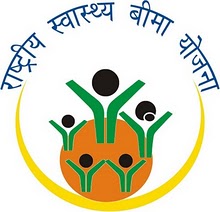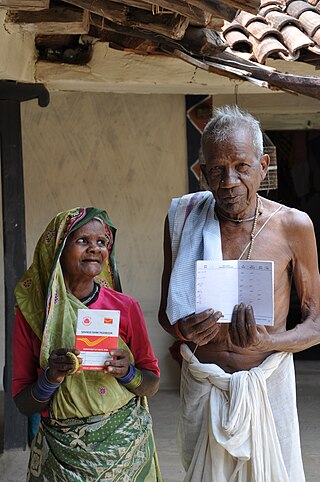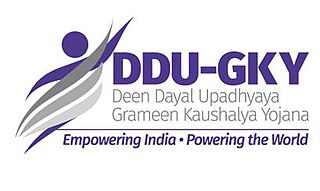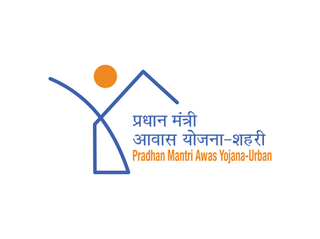Mahatma Gandhi National Rural Employment Guarantee Act 2005 or MNREGA, earlier known as the National Rural Employment Guarantee Act or NREGA, is an Indian labour law and social security measure that aims to guarantee the 'right to work'. This act was passed in 23 August 2005 under the UPA government of Prime Minister Manmohan Singh following tabling of the bill in parliament by the Minister for Rural Development Raghuvansh Prasad Singh.
The Sampoorna Grameen Rozgar Yojana was a scheme launched by the Government of India to gain the objective of providing gainful employment for the rural poor. From 21 February 2003, EAS became an allocation-based scheme. The programme was implemented through the Panchayati Raj institutions.
Social security in India includes a variety of statutory insurances and social grant schemes bundled into a formerly complex and fragmented system run by the Indian government at the federal and the state level and is divided into three categories: non-contributory and tax-payer-funded, employer-funded and lastly, joint-funded. The system has since been universalised with the passing of The Code on Social Security, 2020. These cover most of the Indian population with adequate social protection in various situations in their lives. The Indian social security system is considered to be one of the most generous in the world amongst developing countries. The Central Government of India's social security and welfare expenditures are a substantial portion of the official budget and as well as the budgets of social security bodies, and state and local governments play roles in developing and implementing social security policies. Additional welfare measure systems are also uniquely operated by various state governments. The government uses the unique identity number (Aadhar) that every Indian possesses to distribute welfare measures in India. The comprehensive social protection system of India can be categorised as the follows: social assistance and mandatory social security contributory schemes mostly related to employment. The Code on Social Security, 2020 is part of the Indian labor code that deals with employees' social security and have provisions on retirement pension and provident fund, healthcare insurance and medical benefits, sick pay and leaves, unemployment benefits and paid parental leaves. The largest social security programs backed by The Code on Social Security, 2020 are the Employees' Provident Fund Organisation for retirement pension, provident fund, life and disability insurance and the Employees' State Insurance for healthcare and unemployment benefits along with sick pays. There is also the National Pension System which is increasingly gaining popularity. These are funded through social insurance contributions on the payroll. While the National Food Security Act, 2013, that assures food security to all Indians, is funded through the general taxation. With the passing of the social security code by the Indian Parliament, the fragmented social security system was universalised, resembling the social security systems of most developed countries.
Prime Minister’s New 15 point Programme for minorities is a programme launched by Indian government for welfare of religious minorities in furtherance of reports by committees such as the Sachar Committee Report that highlighted that minorities, especially Muslims, in the country were often in a worse socio-economic and political condition than communities such as the Scheduled Casts and Scheduled tribes communities that have been oppressed over millennia through the caste system. It pegged the status of minorities on various indicators such as nutrition, health, education et al. of minorities and specially Muslims at an abysmally poor level. The 15 point program was the government's response to these finding by laying down guidelines to target minorities in schemes and entitlements that are already in place and designing and executing new schemes aimed at the empowerment of these groups. The programme advocated allocating 15% of plan outlays of welfare schemes identified under the 15 point programme. Mainly, issues of education, credit, housing, employment and communal harmony fall under its ambit.

Below Poverty Line is a benchmark used by the government of India to indicate economic disadvantage and to identify individuals and households in need of government assistance and aid. It is determined using various parameters which vary from state to state and within states. The present criteria are based on a survey conducted in 2002. Going into a survey due for a decade, India's central government is undecided on criteria to identify families below poverty line.
The 2009 Union budget of India was presented by the finance minister, Pranab Mukherjee, on 6 July 2009.
Uttar Pradesh food grain scam took place between years 2002 and 2010, in Uttar Pradesh state in India, wherein food grain worth ₹350 billion (US$4.4 billion), meant to be distributed amongst the poor, through Public Distribution System (PDS) and other welfare schemes like Antyodaya Anna Yojana (AAY), Jawahar Rozgar Yojana and Midday Meal Scheme for Below Poverty Line (BPL) card holders, was diverted to the open market. Some of it was traced to the Nepal and Bangladesh borders, as in 2010 security forces seized Rs 11.7 million worth of foodgrains like paddy and pulses being smuggled to Nepal, another Rs 6062,000 worth of grains were confiscated on the Indo-Bangladesh border.

Rashtriya Swasthya Bima Yojana is a government-run health insurance programme for the Indian poor. The scheme aims to provide health insurance coverage to the unrecognised sector workers belonging to the BPL category and their family members shall be beneficiaries under this scheme. It provides for cashless insurance for hospitalisation in public as well as private hospitals. The scheme started enrolling on April 1, 2008 and has been implemented in 25 states of India. A total of 36 million families have been enrolled as of February 2014. Initially, RSBY was a project under the Ministry of Labour and Employment. Now it has been transferred to Ministry of Health and Family Welfare from April 1, 2015

Pradhan Mantri Gramin Awas Yojana, previously Indira Awas Yojana, is a social welfare programme, created by the Indian Government, to provide housing for the rural poor in India. A similar scheme for urban poor was launched in 2015 as Housing for All by 2022. Indira Awas Yojana was launched in 1985 by Rajiv Gandhi, the Prime Minister of India, as one of the major flagship programs of the Ministry of Rural Development to construct houses for the Below Poverty Line population in the villages.

The National Social Assistance Programme (NSAP) is a Centrally Sponsored Scheme of the Government of India that provides financial assistance to the elderly, widows and persons with disabilities in the form of social pensions.
National Rural Livelihood Mission (NRLM) is a poverty alleviation project implemented by the Ministry of Rural Development, Government of India. This plan is focused on promoting self-employment and the organization of rural poor. The idea behind this program is to organize the poor into SHG groups and make them capable of self-employment. In 1999 after restructuring Integrated Rural Development Programme(IRDP), the Ministry of Rural Development (MoRD) launched Swarnajayanti Grameen Swarojgar Yojana (SGSY) to focus on promoting self-employment among the rural poor. SGSY is now remodelled to form NRLM, thereby plugging the shortfalls of the SGSY programme. This program was launched in 2011 with a budget of $5.1 billion and is one of the flagship programs of the Ministry of Rural Development. This is one of the world's most prominent initiatives to improve the livelihood of the poor. This program is supported by the World Bank with a credit of $1 Billion. The program was succeeded by Deen Dayal Antyodaya Yojana on 25 September 2015.
Deen Dayal Antyodaya Yojana or DAY is one of the Government of India scheme for helping the poor by providing skill training. It replaces Aajeevik. The Government of India has provisioned ₹500 crore (US$63 million) for the scheme. The objective of the scheme is to train 0.5 million people in urban areas per annum from 2016. In rural areas the objective is to train 1 million people by 2017. Further, in urban areas, services like SHG promotion, training centres, vendors markets, and permanent shelters for homeless. The aim of the scheme is skill development of both rural and urban India as per requisite international standards.

Grameen Kaushalya Yojana or DDU-GKY is a Government of India youth employment scheme.

Deen Dayal Upadhyaya Gram Jyoti Yojana is a Government of India scheme designed to provide continuous electricity supply to rural India. The government plans to invest ₹756 billion (US$9.5 billion) for rural electrification under this scheme. The scheme replaced the existing Rajiv Gandhi Grameen Vidyutikaran Yojana.

Pradhan Mantri Awas Yojana (PMAY) is an initiative by the Government of India in which affordable housing will be provided to the urban poor with a target of building 2 crore (20 million) affordable houses by 31 March 2022. It has two components: Pradhan Mantri Awas Yojana(Urban) (PMAY-U) for the urban poor and Pradhan Mantri Awaas Yojana (Gramin) (PMAY-G and also PMAY-R) for the rural poor. This scheme is converged with other schemes to ensure houses have a toilet, Saubhagya Yojana electricity connection, Ujjwala Yojana LPG connection, access to drinking water and Jan Dhan banking facilities, etc. Total 1 crore homes are approved against total demand of 1.12 crore as of 28 December 2019.
Achyut Madhav Gokhale was an Indian civil servant, writer and a former Secretary to the Government of India at the Ministry of Non Conventional Energy Sources, known for his contributions towards the government initiatives such as Village Development Boards and Jawahar Rozgar Yojana.

Pradhan Mantri Ujjwala Yojana was launched by Prime Minister of India Narendra Modi on 1 May 2016 to distribute 50 million LPG connections to women of Below Poverty Line (BPL) families. A budgetary allocation of ₹80 billion (US$1.0 billion) was made for the scheme. The scheme was replaced by the Ujjwala Yojana 2.0 in 2021.
The Nyuntam Aay Yojana was a proposed social welfare programme by the Indian National Congress in its 2019 general election manifesto. It promised that the party, if voted to power in the 2019 Indian general election, would enact a law under which it would distribute cash to the bottom 20 per cent of India's families in terms of wealth, as a minimum guarantee programme. These households would each receive up to ₹72,000 (US$900) a year, a program the Congress claimed would benefit 250 million people in India.

Rajiv Gandhi Grameen Vidyutikaran Yojana (RGGVY) or Rural Electricity Infrastructure and Household Electrification Scheme was launched in 2005 with the aim to provide electricity to all rural areas. In 2013, an amount of Rs. 198.98 crore was sanctioned to the Gorkhaland Territorial Administration (GTA) under this scheme which was later renamed as Deendayal Upadhyaya Gram Jyoti Yojana and recently as "saubhagya" This scheme aimed at electrifying all villages and habitations, Providing access to electricity to all rural households andProviding electricity connection to Below Poverty Line (BPL) families free of charge. To augment resource capacities for implementation of this scheme, Ministry of Power, Govt. of India involved CPSUs like NTPC, NHPC, PGCIL and DVC for making available their project management expertise and capabilities to the states willing to use their services. Anyishi Youth Association (ANYA) claimed that there were scams involved the CM under Rajiv Gandhi Grameen Vidyutikaran Yojana (RGGVY) scheme. As in April 2015, only 910 villages were yet to be electrified, which account for 5% of India's un-electrified villages excluding some uninhabited villages but around 35 million households i.e., approximately 11% of the total rural households were yet to be electrified.








